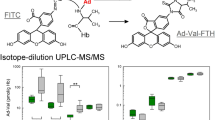Abstract
Objective: The influence of the polymorphic human glutathione-S-transferase (GST) T1 and M1 genotypes (classified as “conjugators” and “nonconjugators”) on the biological effects of nonoccupational ethylene oxide exposure as reflected by the formation of globin N 2-hydroxyethylvaline adducts was investigated. Specific attention was paid to smoking as a potential source of exposure. A total of 27 Caucasian subjects, including 10 women and 17 men, participated in the study. Volunteers were grouped as smokers, i.e., 6 subjects (5 male, 1 female), and nonsmokers, i.e., 21 subjects (12 male, 9 female). The regular cigarette consumption in the smoker group ranged from 10 to 25 cigarettes/day. Methods: The amount of N 2-hydroxyethylvaline (HEV) bound to the N-terminal valine in human globin was determined following a procedure described by Bader and co-workers and the Deutsche Forschungsgemeinschaft. The GST genotypes were determined by a polymerase chain reaction (PCR) analysis outlined by Bell and colleagues (with β -globin serving as an internal standard) and Kempkes and co-workers (coamplification of the GSTT1 fragment). Results: The median level of HEV detected in the smoker group was 280 pmol/g globin as compared with the median value of 50 pmol/g globin recorded for the nonsmokers, indicating that ethylene oxide intake from cigarettes may result in a ∼5-fold higher overall HEV level in smokers in comparison with nonsmoking individuals. No dose-effect correlation was observed between daily cigarette consumption and the resulting HEV levels. Moreover, the individual GSTT1 or GSTM1 genotype did not influence the HEV level in smokers. The subgroup of nonsmoking GSTT1 conjugators revealed a median HEV value of 46 pmol/g globin as compared with the median value of 92 pmol/g globin found in the nonconjugator subgroup. Subjects with the GSTM1 gene had a median HEV value of 55 pmol/g globin, whereas subjects with the gene deletion had a median HEV value of 44 pmol/g globin. The 2-fold increase in the median HEV value detected in GSTT1 non-conjugators as compared with GSTT1 conjugators indicates an influence of GSTT1 on the globin HEV levels. This hypothesis was found to be significant in the nonparametric Mann-Whitney U-test for independent samples (P < 0.002, two-sided). The same test was applied to evaluate the influence of GSTM1 on the globin HEV levels. No significant influence was observed (P > 0.10; two-sided). Conclusions: This result is in accordance with the finding that ethylene oxide is a substrate for GSTT1 but not for GSTM1. In addition, this study demonstrates a clear influence of genetically determined GSTT1 status on biological effects, e.g., protein adduct formation after non-occupational ethylene oxide exposure. In smokers, however, a modulating influence of GSTT1 status was not observed.
Similar content being viewed by others
Author information
Authors and Affiliations
Additional information
Received: 29 December 1997 / Accepted: 27 June 1998
Rights and permissions
About this article
Cite this article
Müller, M., Krämer, A., Angerer, J. et al. Ethylene oxide-protein adduct formation in humans: influence of glutathione-S-transferase polymorphisms. Int Arch Occup Environ Health 71, 499–502 (1998). https://doi.org/10.1007/s004200050312
Issue Date:
DOI: https://doi.org/10.1007/s004200050312




